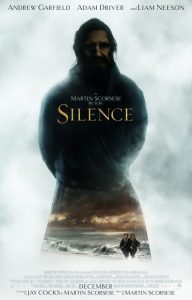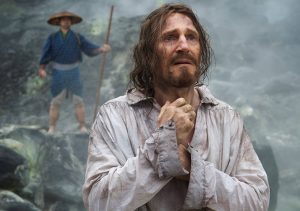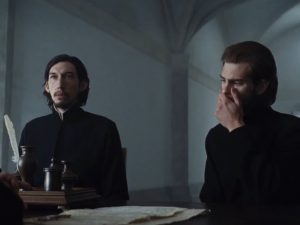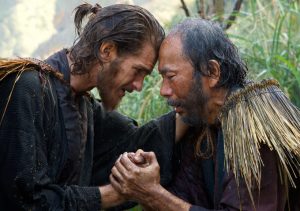
“Silence” is a passion project for Martin Scorsese through and through. He has spent the last twenty-five years developing the adaptation of Shūsaku Endō’s novel, the third in film alongside a play and various musical compositions. It has become a passion project for his fanbase, which I am a part of, who have been waiting with bated breath ever since his announcement. Because of this, the film comes equipped with heavy baggage in the form of great expectation. Anything less than a masterpiece would be a disappointment.
While this adaptation comes within a few hairs short of a masterpiece, I wouldn’t deem it a disappointment. I got out of it what I desired: a powerful and thought-provoking analysis of faith, religion, and power. I was enamored throughout the screening and have been thinking about it fervently ever since leaving it. My qualms, as minor as they are, are ultimately forgiven in the face of objectivity; an understanding of Scorsese’s reasoning for them softening the blow. I may still have my grievances with the length, which is a little too long in the tooth, and the heavy-handed symbolism & narration, but I wouldn’t dare call them amateurish mistakes. I wouldn’t even refer to them as mistakes, but differences of opinion.

Take for instance the heavy-handed symbolism & narration. Both are the result of the broken psyche of Jesuit priest Sebastião Rodrigues (Andrew Garfield). He has traveled to Japan in search of Father Cristóvão Ferreira (Liam Neeson), having performed apostasy in favor of mercy from torture. He believes it to be slander, finding it impossible to accept that his teacher, a devout Christian who had done the Lord’s work in bringing Christianity back to Japan, would even think of denouncing his faith, let alone go through with it. Along with Francisco Garupe (Adam Driver), he travels in Japan to continue his master’s work whilst in search for him.
Rodrigues’ narration guides the film, framed as if they are letters written in the same verbiage as Ferreira’s. This automatically defeats the notion that it exists to hold the audience’s hand, as it is actually a reflection of the priest’s mindset. It plays into the notion that he is an arrogant fool with a God complex that the Japanese drill into his skull. Scorsese toys with that notion, forcing the audience to question if the priest’s faith is of the detriment of the citizens he so desperately wants to save. Even so, I found some of the narrations too on-the-nose, distracting from the impact of the happenings. A justifiable existence, but one that is arguably played too often.

As for the symbolism, it is but two moments that irked me ever so slightly. Both are hallucinations (or at least perceived as such) brought upon by Rodrigues’ broken psyche. The first comes visually. Having been separated from Garupe following the torturing of Christian followers and rejected by the natives, Sebastião retreats defeated into the dangerous forests. Aided only by Kichijiro (Yôsuke Kubozuka), a meek native who crumbles under pressure, he happens upon a stream. Amidst his consumption, he sees a vision of Jesus Christ superimposed over his reflection, causing him to go mad. The second comes audibly. It is the voice of Jesus Christ speaking unto him, with words I don’t dare to spoil. Both represent Rodrigues’ struggles with his faith, but again, I found they were a bit too on-the-nose.
Then there is the runtime, which is two-hours and forty minutes. It certainly lingers for a bit too long, the slow pace not helping matters. That is deliberate, as Scorsese is testing the patience of the audience just as the priests’ faith are being tested. The slow pace helps set the mood of bleak despair, the lingering sequences slowly chipping away at the mental stability of both the audience and characters. It also aids in developing the scope, making up for brief time lapses. I could feel the length of the priests’ ordeal. Even so, I felt the film could’ve used a little trimming, a hard task for Marty to do on a (long and arduous) passion project, no doubt.

None of these issues detracted heavily from the overall experience, however. If anything, they added to it albeit overzealously. The more I think about them, the more I realize just how much I appreciate their touches. They may not be as subtle as the edgy symbolism contained within the torture scenes, but they’re not supposed to be. They serve their purpose in highlighting the emotional and mental freefall of Rodriguez; subtle in their own right as they hint at Father Ferreira’s similar, imperceptible descent into madness.
The central themes on religion, faith, and power ring through spectacularly! I loved how Inoue (Issei Ogata) & the Interpreter (Tadanobu Asano) not only manipulated Rodriguez, but myself as well. As they force him to question his beliefs, I too began to question him. Is his desire to spread the word of Christianity a result of compassion or narcissism? If it is the former, is it worth the lives of his followers, whose tortures include drowning, burning, and scalding water poured through tiny holes as to prolong the agony? Is his refusal to accept another country’s religious beliefs damning his followers to a lifetime of anguish, all the while he is forced to simply sit back and watch from his cell? Is he truly being punished or using his agenda as an out? Kudos to Garfield for swaying my perceptions, hinting on occasion at conceit all the while never losing his endearing empathy.

Of course I don’t side with Inoue and his crew, as they resort to torture to punish those who dare defy their religion. They exhibit the most disgusting hypocrisy and yet their accusations sting. Where it backfired on them, and is brilliant on Scorsese’s part, is in showcasing human compassion. While this is a film based on religion, the faith isn’t necessarily exclusive to it. As Rodriguez watches in agony as his followers are tortured, I thought of those who would besmirch non-believers as having no empathy in this situation. I believe they would as any moral human exhibits empathy. They may not share the religious symbolism such as crosses that could exploit them, but the followers themselves act as that. Think of a person whose sole purpose in life is establishing human rights. Would that person not stand their ground just as Rodrigues does and be demonized in the process? Rodrigues himself brilliantly foreshadows this in one of his narrations when he questions if giving out little symbols of faith distracts his followers from obtaining the spiritual faith they should aspire to attain.
It is provocative ideas such as that that tramples the few gripes I have with the film. They may prevent the film from being a flawless masterpiece, but that is only representative of this first viewing. Multiple viewings are in order to fully grasp the density on display and, as shown in my ponderings, those gripes may blossom into advantages. Not that it matters. Masterpiece or not, “Silence” is stimulating, both emotionally and mentally. That’s all I desired in the first place.
Final Rating: A-
